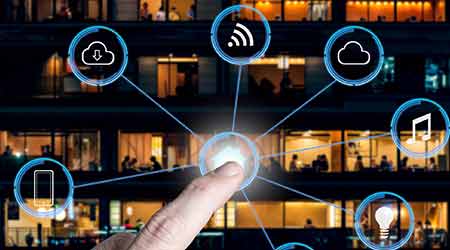Understanding Your Building Internet of Things Options
As technology rapidly changes, facility managers should study the best and most efficient ways to add function and capability to their current operation.
Building management technology is rapidly changing. The advent of cloud computing and big data, plus the proliferation of smart meters and other Internet-connected “things,” all provide more data-driven outcomes for buildings and their subsystems. These Building IoT developments present opportunities and challenges to facility managers. Opportunities include an increase in data that can lead to greater efficiency, avoided equipment repairs, and lower operating costs. But these new sources of data require training and ongoing staff time to properly analyze the outputs and take action. Procuring new Building IoT technologies may require new vendor relationships, too. And there are many new vendors in the building technology space, primarily selling software-enabled solutions to building owners. Various analyst and research firms cite between 150 and 250 startups with operations-focused building technology software solutions.
The market for these technologies is fragmented and complex. One way to understand this rapidly expanding landscape is by type of offering. Building technology requires a number of components that form a technology stack. This stack is made up of a variety of hardware and software components. In some cases, a firm will build all of the stack components (or a significant number of them) and in other cases, a firm will simply focus on a single part of the stack, selling the technology to a variety of other vendors across different building types.
Technology platforms: Core components
“Stack” is a term used in the software industry referring to integrated products and services that act as components of an overall platform and provide a full solution to end users. The technology stack is evolving but includes a few core components:
• On-premise hardware: Within commercial buildings, many hardware devices act as sensor points, including thermostats, HVAC components, lighting fixtures, and energy meters.
• On-premise networking/communications: This includes the various protocols, like BACnet and Modbus, which allow on-premise hardware devices to communicate with each other.
• On-premise software: Software applications that enable facility managers to operate their systems (such as HVAC), monitor trends, and take action. (Note: Some of these software products can be accessed from outside the building via remote connection.)
• Building-to-cloud communications: As buildings become connected to the cloud, there are hardware gateway products that use application programming interfaces (APIs) and Internet access to send data to the cloud.
• Cloud platforms: Once the building data has been sent to the cloud, it can be used for a variety of applications (visualization, analysis, reporting, etc). Additionally, there are other relevant sources of data, such as weather, utility bills, and rate tariffs, which can be imported to these platforms. Some of the data providers (for weather, bills, tariffs) could become cloud platforms in the energy industry.
• Cloud applications: The line between cloud applications and cloud platforms in the building industry is grey. That said, some vendors focus on purpose-specific applications (e.g., an occupant dashboard for engagement) rather than a full-featured platform and ecosystem. Some platform providers have begun to open up to third party application developers, which is a model similar to Apple’s App Store.
• Implementation and integration services: This is not typically thought of as part of a traditional technology stack. But because there are so many systems integrators in the building space, and some of them build their own software, they should be included.
Vendors that build the majority of this technology stack are delivering a vertically integrated solution. Vendors that focus on a single component within the stack take a horizontal approach. An example of a vertical solution is a next-generation intelligent building automation system, which may have proprietary metering hardware to collect granular energy data, technology to send this on-premise hardware data to the cloud, analysis capabilities to identify anomalies, and a user interface to deliver this information to users. An example of a horizontal solution is a hardware device that can collect a specific stream of data, such as energy demand (kW), which can be integrated with other installed software, such as an existing BAS.
Related Topics:










